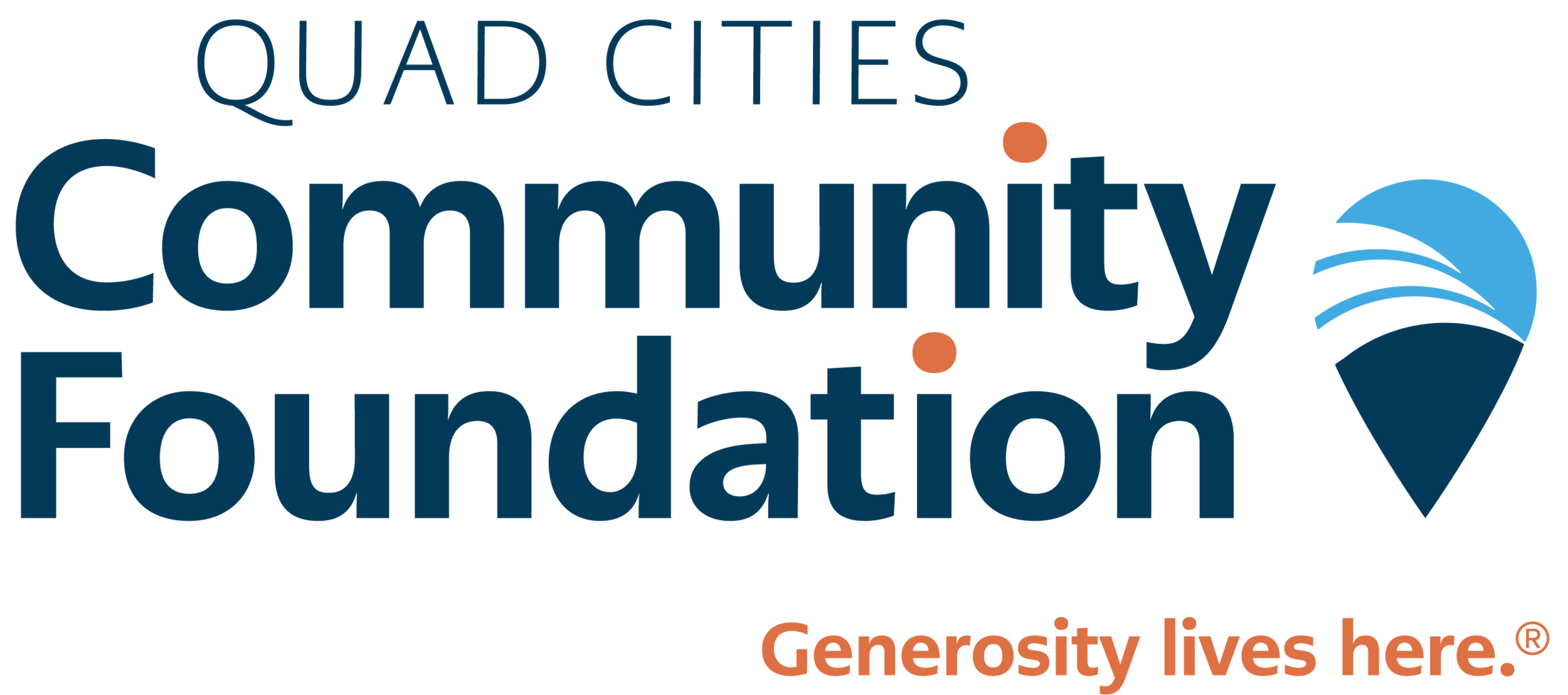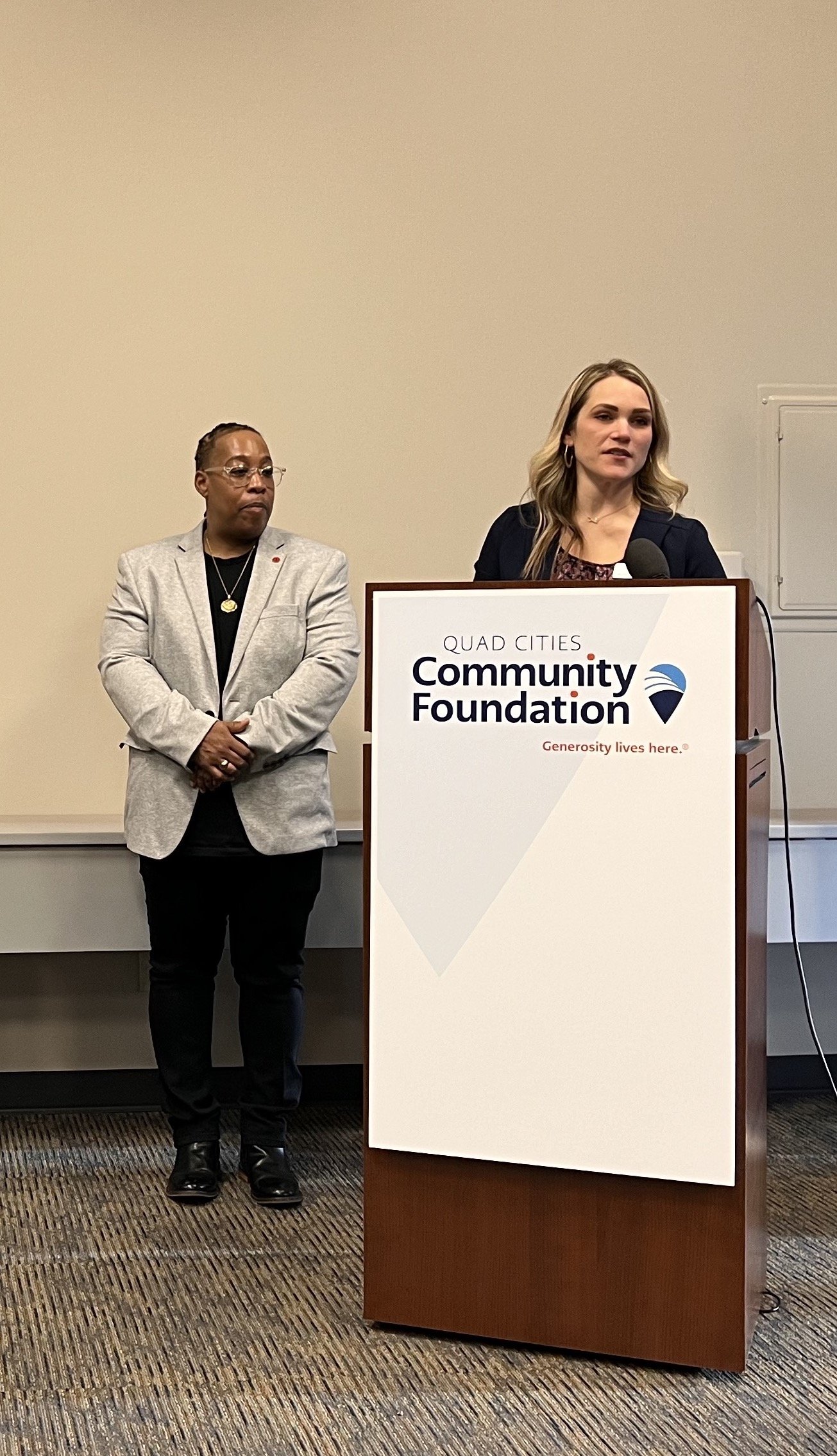Quad Cities Community Foundation grants $300,000 for reducing gun violence
three-year Transformation Grant will build social service, community volunteer, and research capacity of local Group Violence Intervention strategy
From left to right: Kelly Thompson, Tee LeShoure, Dwayne Hodges, Nicole Cisne Durbin, Chief Jeffrey Bladel, Mayor Mike Matson, Sarah Ott, Sue Hafkemeyer
Dwayne Hodges still remembers the run-ins he had with police as a young man. They may not all be happy memories, but today he’s working hand in hand with the Davenport Police Department and nonprofit Family Resources to help turn the tide on gun violence in the Quad Cities community. “I want to be a voice to those who have had adversity come into their lives,” said Hodges, who is a community organizer, a certified substance abuse counselor, and a pastor. “Being someone with reach in the community and a personal backstory helps me help others look at life from a different perspective.”
Hodges has spent the last eight months volunteering to help roll out Group Violence Intervention (GVI), a strategy to reduce violent crime adopted by the City of Davenport last year. GVI brings together law enforcement, social services, and credible community voices like Hodges’s with a unified message—“we want to see you safe, alive, and out of prison”—to reach people at the highest risk of violent offending or victimization.
The team behind GVI has successfully contacted upwards of 70 at-risk individuals since the strategy launched last spring. As they look to build on that success in 2023 and beyond, they’re focused not just on reaching more people but also on deepening the connections they’ve already established.
Now, a $300,000 grant from the Quad Cities Community Foundation will turn that goal into a reality. With the strategy’s foundation firmly in place, the three-year Transformation Grant will build critical capacity for Family Resources and GVI’s community volunteers, as well as for evaluation of the strategy’s effectiveness and impact. Transformation Grants are made possible by the generosity of donors who give to the Community Foundation’s Quad Cities Community Impact Fund.
“Complex community challenges like this can only be solved through collaboration.”
“Complex community challenges like this can only be solved through collaboration,” said Sue Hafkemeyer, president and CEO of the Community Foundation. “We’re excited to see an innovative tool for promoting racial equity and ensuring our community is safe for everybody who calls it home. By supporting this effort now, we believe we can transform it into the wider regional strategy needed, activating the entire community together.”
With proven success in cities like Boston, Chicago, and South Bend, GVI is a unique model for reducing gun violence. Complementing other efforts to tackle the broad systemic issues that may intersect with violent victimization and offending—from poverty to affordable housing and childcare—GVI takes a “focused deterrence” approach, homing in on victims and offenders themselves to build trust and provide services and resources that could help them stay safe.
Dwayne Hodges
In Davenport, just 0.19 percent of the population is involved in roughly 55 percent of the city’s gun violence, meaning that carefully calibrated outreach can go a long way toward addressing the problem. Violent victimization and offending disproportionately impacts Black males aged 19 to 34, a group typically underserved by social services and facing many systemic disadvantages. In many cases, victims become offenders and offenders become victims in a cycle of violence.
In its first phase, GVI teams have reached out to almost every person known to have actively engaged in violence in Davenport in the past three years. Of the 75 individuals reached as of this past December, only three went on to be involved in gun violence afterward. “Sometimes you can look at the headlines and feel like this is a problem we’re never going to wrap our arms around, but that’s not true,” said Sarah Ott, the City of Davenport’s chief strategy officer. “We can, and we are.”
Another unique aspect of GVI is the way law enforcement partners with social services and community leaders to carry it out. During what are called “custom notifications,” a team of representatives from the police, Family Resources, and the community approach individuals to open lines of direct and respectful communication. The goal of those meetings is for everyone involved to convey the message that the violence must stop and to make a sincere offer of help, setting the stage for Family Resources to provide those victims or offenders highly individualized trauma-informed social services. As a last resort, law enforcement reserves strategic consequences if the individual continues to engage in gun violence after the meeting.
“You don’t usually see law enforcement, social services, and community members show up together,” said Tee LeShoure, who leads Family Resources’ Survivors of Homicide and Other Violent Crimes team. “When all three collaborate together, it sends a different message. It’s a different dynamic. It’s something I’ve never seen before.”
Tee LeShoure and Nicole Cisne Durbin
A significant portion of the Transformation Grant will allow Family Resources to dedicate an existing staff member from LeShoure’s team solely to GVI outreach and follow-up. A smaller share will furnish honoraria to community members like Hodges who have volunteered their time and talents to participate in custom notifications. Building the capacity of these two groups is essential for GVI to truly make a difference with the individuals it reaches.
“Oftentimes, people may not be receptive to accepting services right away,” Ott explained. “What it takes is trust-building with our social services providers and our community members, and you can’t build trust without continual engagement. With the Quad Cities Community Foundation’s Transformation Grant, we will now have the capacity in Family Resources and our volunteers to continue those conversations and follow through on our offer to help.”
With this added capacity also comes the opportunity for social services and the wider community to step toward long-term ownership of violent crime prevention. “Even before GVI, Family Resources was asking how we can move further upstream to address these issues earlier,” said Nicole Cisne Durbin, Family Resources’ president and CEO. “We want to be proactive in figuring out how to help our community access the things they need so that they don’t have to resort to violence.”
Looking ahead, the opportunity for GVI to expand beyond Davenport is clear. It’s also a necessity, given that crime doesn’t adhere to borders. “We need this strategy to be region-wide,” said Cisne Durbin, noting that Family Resources already has a presence in Illinois. Now that the model is built and growing in Davenport, it will be easier to recreate across the river, for example in Rock Island.
Finally, the grant will fund research and evaluation by St. Ambrose University’s Institute for Person-Center Care, an interdisciplinary body combining public health and criminal justice, to measure GVI’s effectiveness and lay the groundwork for additional funding opportunities in the future, a must for the strategy’s long-term sustainability.
“We understand that gun violence is a problem for our whole community to solve and that strategies like GVI are going to require continued investment to be successful,” said Hafkemeyer. “We hope that by shining a light on the partnerships and relationships that have driven GVI’s impact so far, we can inspire others to consider how they can be a part of the effort.”
“If you want things to change—if you want the violence to stop, if you want to transform lives—you have to be a part of the solution,” added Hodges. “This is a different way of helping people. We are giving people a hand up to help make changes in their lives, and sometimes they just need to hear somebody say, ‘I care about you.’ That’s what GVI is doing.”



